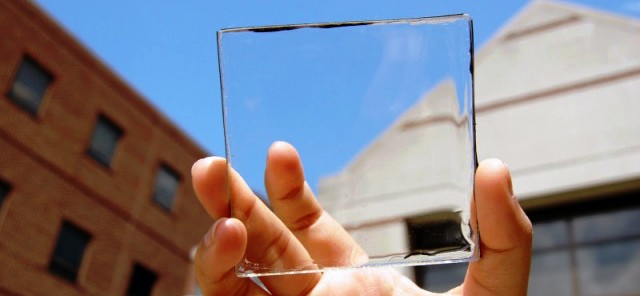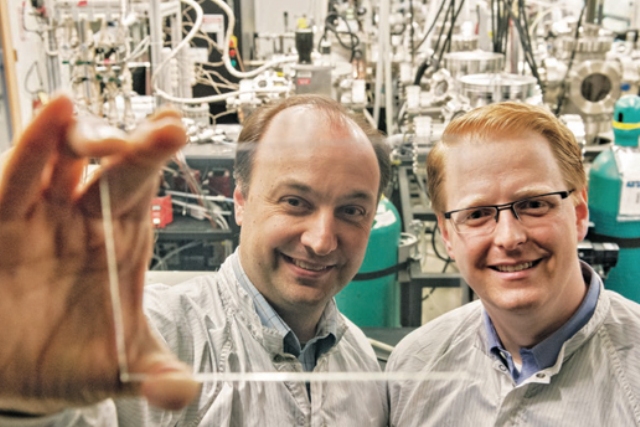
MIT scientists are making solar cells that could make ordinary items, such as, windows and electronic gadgets create their own power, without adjusting what they look like, or hold the capacity to power them via battery today. These new cells are capable of absorbing infrared and ultraviolet light only. Visible light goes through the cells unobstructed, so our eyes do not know they are there. Furthermore, the analysts have used coatings on their new solar cells, which consist of different materials, and have employed them to be used in displays utilizing encompassing light. They think that utilizing covered windows in skyscrapers could give more than a quarter of theses building’s energy needs without transforming their appearance. They are presently starting to coordinate their sun based cells into buyer items, including cell phone displays.
Image Source: Justin Knight / MIT – Vladimir Bulović of electrical engineering and computer science (left), Miles Barr PhD (right), are making transparent solar cells that could one day be deposited on everyday objects, from mobile devices to windows, turning surfaces everywhere into low-cost energy harvesting systems. This research was supported by the MIT Center for Excitonics, an Energy Frontier Research Center funded by the US Department of Energy.
Creating another solar cell that can compete financially with today’s solar cells is difficult, given existing arrangement methods. However, a photovoltaic (PV) cell can bend all these rules. It could be stored on any surface without darkening the look of the basic material. “You can have zebra stripes or elephant foot shaped impressions or whatever you need underneath in light of the fact that the phones that sit on top are imperceptible,” says Vladimir Bulović, professor of electrical engineering and chief of MIT’s Microsystems Technology Laboratories. “They could be on everything around you. Including every one of your windows and you would not even notice them.”
The design was inspired by Lunt’s idea, the group that originally created the transparent cell. The thickest layer (toward the left) is the glass, plastic, or other transparent substrate being coated; the multiple layers of the PV coating are toward the right. At the core of the coating are the two active layers; the absorptive semiconductor materials that get excited by sunlight and interact, creating an electric field that causes current to flow. Sandwiching those layers are electrodes that connect to the external circuit, which carries the current out of the device. Both of the electrodes must be transparent and not the usual reflective metal. Furthermore, a layer on the back of the cell can be added to reflect sunlight of selected wavelengths, sending it back for a second pass through the active layers. Finally, anti reflective coatings can be used on both outside surfaces to reduce reflections, because any light that potentially reflects as much as ten percent of the total, does not go through the device.”We utilize a blend of atomic designing, optical configuration, and gadget streamlining a comprehensive way to deal with planning the straightforward gadget,” says Barr who co-founded a company with Lunt, Bulović, & Bart that is called Ubiquitous Energy, a name that reflects their vision of PVs seamlessly being deployed throughout our everyday life.
Image Source: MIT – This schematic diagram shows the key components in the novel transparent photovoltaic (PV) device, which transmits visible light while capturing ultraviolet (UV) and near-infrared (NIR) light. The PV coating—the series of thin layers at the right—is deposited on the piece of glass, plastic, or other transparent substrate. At the core of the coating are the active layers, which absorb the UV and NIR light and cause current to flow, via the two transparent electrodes, through an external circuit. The reflector sends UV and NIR light back into the active layers, while the anti-reflective (AR) coatings on the outside surfaces maximize incoming light by reducing reflections.
However, the expense of executing this technology will differ with the custom application, solar cell proficiency, and other different factors. For example, the procedures utilized, as a part of creating the new PV cells, are environmental friendly and not energy intensive. In fact, the coatings are kept at about room temperature, so the solar PV cells can be fixed on basically any kind of surface. There is no compelling reason to utilize glass, which is an unreasonable part in the manufacture of traditional frameworks.
Perceiving the business capability of this innovation, they are proceeding with improvement work to streamline their PVs, utilizing distinctive semiconductor materials and gadget arrangements that will prompt higher efficiencies and better transparencies. Also, they are making sense of how to incorporate the PVs into customer items that will perform their standard capacities and harvest energy.
You want to discuss a certain topic with likeminded people or you want to organize a local protest or you have an idea for a project that can help people in need in your local community or all around the world? Join our forum! www.anonboards.com
You want to support Anonymous Independent & Investigative News? Please, follow us on Twitter: Follow @AnonymousNewsHQ
Source: Extreme Tech, PV-Magazine







Car Windows, Digital Billboards, anything can be replaced with this even if it has to be double paneled it would be great.
This is amazing, technology is really advancing specially in solar power industries. I do hope that they succeed in this project. Thank you for sharing this article.
http://arizonaaccurate.com/
It would be awesome if these get to be good enough that we wont need chargers during the day.